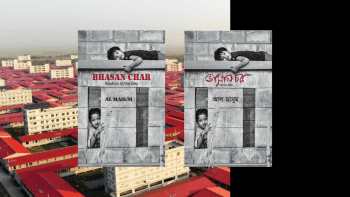An invaluable resource on char dwellers of deltaic Bangladesh

In the contemporary discourse on Bangladesh, its cultural legacies have overtaken its identity as a land of six seasons or as a riverine country. A degree of euphoria is associated with both sets of images. Consequently, attention has been inadequate to the hard realities of the country's geographical, geological or geo-physical characteristics associated with its location in an active delta with floodplains, riverbank erosion, accumulation of sediments, formation of channels, morphological instabilities, plus landslides in its hilly region. This reality calls for geography, geology, and geomorphology as part of our education and research. The recently formulated Bangladesh Delta Plan (BDP) 2100, despite its grandiose scale, bears some potential to influence changes in the education system—it can make it easier to build safe settlements for residents, away from the vulnerable areas.
Meanwhile, a pioneering knowledge creation task has been accomplished in the form of a 2021 Springer book, Living on the Edge: Char Dwellers in Bangladesh, a compendium of 45 contributors including the book's two editors, Mohammad Zaman and Mustafa Alam. The five rivers and corresponding estuarine char regions of Brahmaputra-Jamuna, Ganges, Jamuna-Ganges, Lower Meghna, and the Meghna Estuary system are sources for data on land eroded, accreted and thereby the gain and loss of land and the geophysical characteristics that define the nature of their soils. Twenty million people—12.5 percent of the country's population—live in chars, which accounts for eight percent of land, much of which is unsettled land. Another 15 to 20 million people live along the banklines of the rivers, in fear of displacement from riverbank erosion.
Three of the major topics in the book address issues related to riverbank erosion and char lands dynamics; they assess the consequence of these instabilities in human terms; and examine the policy, planning and management for improving the conditions of char dwellers.
In some instances, their fate assumes episodic dimensions, as was the case in the 1970 Bhola disaster and in the 1985 Urir Char tidal surge that washed away thousands of people. Living on the Edge presents documented evidence and information on life and livelihood adversities of a chronic nature that are routinely endured by char dwellers and erosion-prone river bank line inhabitants from one generation to the other. This reality led distinguished geographer, Hugh Brammer, to recommend devising "forms of productive economic use of char land that do not require people to live in such hazardous environments"—a strategy that essentially turns a labour-surplus economy to a labour-scarce economy. Bangladesh's development process is not dissimilar to this. The question is: how long will it take to pull up the labouring poor from such disaster-prone living environments?
Most of the book's contributors, therefore, focus on char dwellers' existing fearful living, livelihood conditions, and the means for improving upon them. The highlights include vulnerabilities arising from natural disasters such as flood, erosion, storm, cyclone, tidal surge; poverty—which is 2.7 times higher than the national average—and its consequent malnutrition; illiteracy; inadequate education, health and sanitation services; and limited rights to, if not absence of, land and livelihood resources. An ambiguity in entitlement arises because, in some instances, char dwellers serve a vanguard role to legal owners of the newly formed char land who do not move to chars until char living becomes safe. Usually, the poor labouring class from the neighbouring mainland or floodplains, either on their own or with consent of the original owners, move to the newly emerging chars. This is taken advantage of by the "local goons who torment the char dwellers continually".
This book will serve well those who seek to know what it is like for these dwellers to live in chars in the middle of our mighty rivers or their estuaries, and what it will take to improve their conditions.
ATM Nurul Amin is Professor Emeritus, Asian Institute of Technology.

 For all latest news, follow The Daily Star's Google News channel.
For all latest news, follow The Daily Star's Google News channel. 





Comments